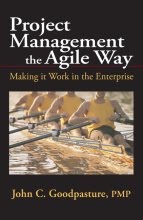There's no time like the present: Let's start now to figure out how project value is going to morph into business value. Hopefully, your question is not "what is business value?". That question should have been answered in the business case. So, I'll presume it was, and move on.
Adoption may be slow. Do you recall
Kurt Lewin's model for change ? (it was postulated in the 1940's. And, if your recognize the name, he's the guy also credited with Force Field Analysis). The model is actually pretty simple (three steps), but it gets at the "slow adoption" thing:
- Unfreeze, meaning overcome inertia, get everyone on the same page, and create the urgency or passion for the change
- Make the change, meaning roll it out and then work on the kinks
- Re-freeze, meaning institutionalize the change so that it sticks
Well, of course, if there's one rollout, and one adopter community with one set of attitudes, then Lewin's process fits. Modern business is more complex (it probably was in the '40s also, but models need to be simple to get traction) so this three stepper may not fit today's business dynamic exactly as posed, but it's got the seeds of the right things to do.
Let's start with unfreezing. Assume there's an effective "change is coming" communication campaign, and assume there are some incentives for managers to get on board. What about those that are volunteers, like customer and users?
Let's start with Early Adopters
There are, of course, those who will eagerly grab new capabilities, especially technology capabilities rich in software features and functions, and especially those that are user-configurable. So, let's make it easy for them.
- We need easy access to the change (product, process, or whatever)
- We need good personal support in the beginning that can morph to more institutional support later
- We need the supply chain on board;
- We may need other third party partners on board.
- We've got to decide how private and proprietary this change is going to be, or how much of the intellectual property is going to be made available to others.
- We need a process for absorbing what the EA's tell us so that for those adopters that come later they will be more satisfied.
But early adopters are only one of five personalities in the body of knowledge known as
diffusion of innovations. Because of the natural reluctance to change, embracing new capabilities may not be automatic. To encourage adoption, competing or legacy capabilities should be withdrawn as soon as practical.
The five are:
1.
Innovators: Those who are anxious to work with the product in a preproduction or beta status and take risks with immature product; usually very personable and networked individuals, well connected with technology, and able to handle a high degree of uncertainty;
2.
Early adopters: Those with opinion leadership eager to put product through its paces and be first on the block to have the advantage of a new capability;
3.
Early majority: Those willing to adopt after visible proof that the bugs have been worked out and operational effectiveness has been proven;
4.
Later majority: The reluctant but willing, not too comfortable giving up what they know best; and
5.
Laggards: Those that might never adopt and so drop out of the pool of users.
Innovators often make their own decisions to engage using new ideas; they are often in at the beginning and may be drivers behind the original vision. Early adopters may wait for official sanction before taking up a new product; later adopters may be forced by decision makers to get involved. Regardless,
Everett Rogers, one of the early academics in the theory of diffusing innovation, posits that everyone passes through a five-stage decision-making process, albeit on difference timelines.
Roger’s paradigm is:
1.
Seek knowledge: Seek basic information to become familiar and acquainted with a new idea, product, or service;
2.
Accept persuasion: Evaluate benefits in context of personal use and application;
3.
Decide: Decide to adopt or reject;
4.
Implement: Begin to apply the product or service to the everyday routine; and
5.
Confirm: Accept the product as a fully qualified alternative to the prior capability.
When you think about it, Roger's paradigm simply added a bit to Lewin's three stepper, but they largely are in agreement.
And, one other thing from my experience:
- Remove the legacy (you can't hang onto what you don't actually have)
- Deploy 'ambassadors' to every functional unit who are expert. Their job is to nip any whining in the bud






